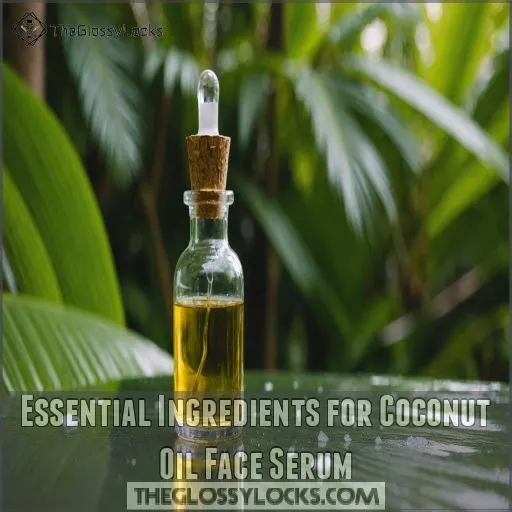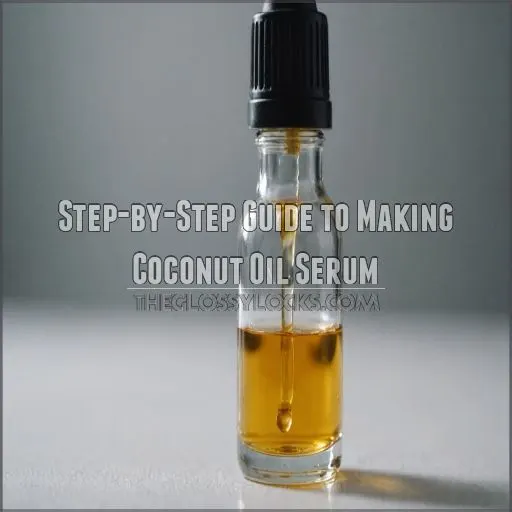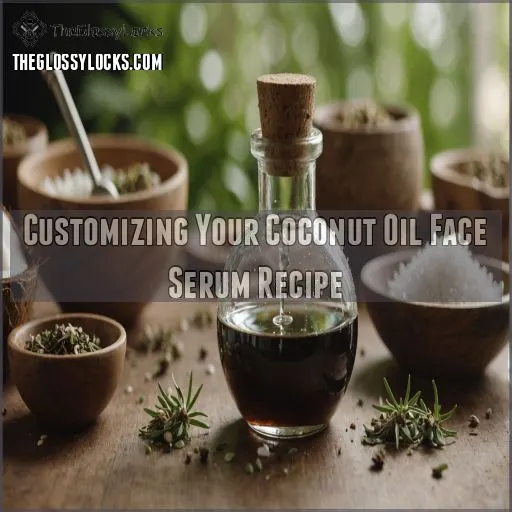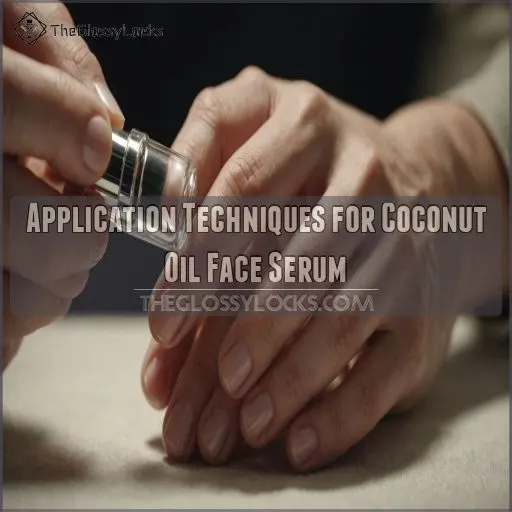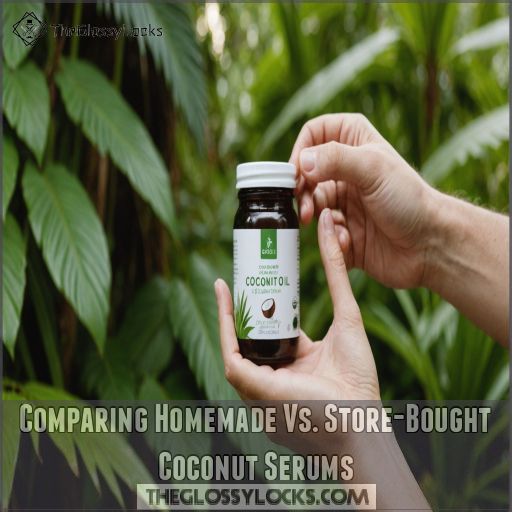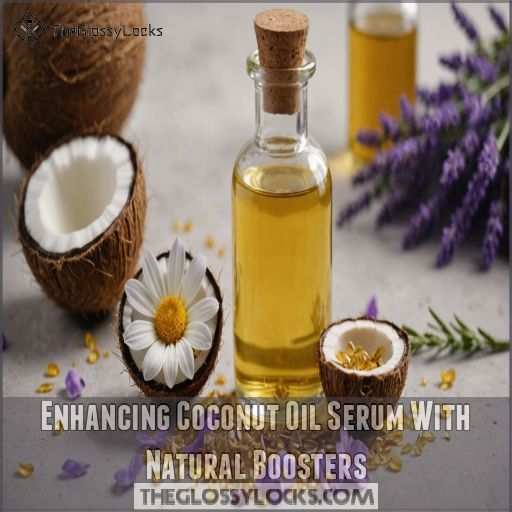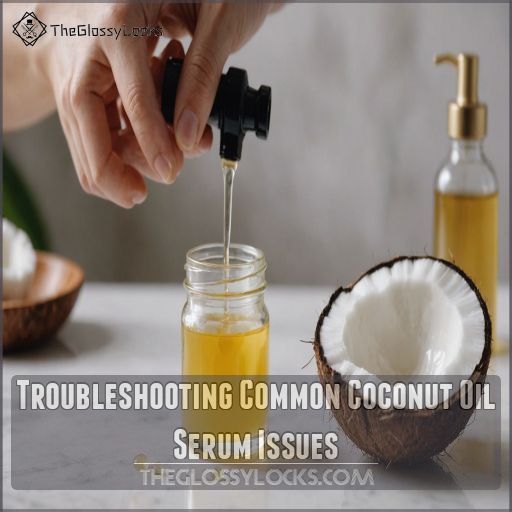This site is supported by our readers. We may earn a commission, at no cost to you, if you purchase through links.
 Making a face serum with coconut oil is like giving your skin a tall glass of water – but with benefits!
Making a face serum with coconut oil is like giving your skin a tall glass of water – but with benefits!
Start by blending equal parts coconut oil and a carrier oil like jojoba or argan.
Add a drop or two of your favorite essential oil: tea tree works wonders for acne-prone skin.
For an antioxidant boost, toss in a bit of vitamin E.
Mix thoroughly and store in a cool, dark place.
Apply sparingly and let the magic happen.
It’s like cooking up a skincare potion right in your own kitchen!
Stick around for more tips and tricks to perfect your blend.
Table Of Contents
- Key Takeaways
- Benefits of Coconut Oil in Face Serums
- Choosing the Right Type of Coconut Oil
- Essential Ingredients for Coconut Oil Face Serum
- Step-by-Step Guide to Making Coconut Oil Serum
- Customizing Your Coconut Oil Face Serum Recipe
- Application Techniques for Coconut Oil Face Serum
- Potential Side Effects and Precautions
- Comparing Homemade Vs. Store-Bought Coconut Serums
- Enhancing Coconut Oil Serum With Natural Boosters
- Troubleshooting Common Coconut Oil Serum Issues
- Frequently Asked Questions (FAQs)
- What is the best homemade face serum?
- Is coconut oil a good face serum?
- How to make your own anti-aging serum?
- What is the best oil for homemade face serum?
- How long does coconut oil serum last?
- What skin types benefit most from coconut serum?
- Can coconut serum be used on hair?
- Is refrigeration necessary for coconut oil serum?
- How to store coconut serum for travel?
- Conclusion
Key Takeaways
- Start your coconut oil face serum by combining equal parts of coconut oil and a carrier oil, like jojoba or argan. Add a drop or two of your favorite essential oil for a personalized touch. Don’t forget to include vitamin E for an antioxidant boost – your skin’s version of wearing a superhero cape.
- Coconut oil is more than just a tropical treat – it’s a moisture magician. It penetrates deeply, locking in hydration and aiding in reducing inflammation. However, beware that it can be a double-edged sword for oily skin, potentially causing clogged pores.
- Choose the right coconut oil for your serum. Unrefined coconut oil packs more nutrients, while fractionated coconut oil is lightweight and non-comedogenic – ideal for acne-prone skin. It’s like choosing between a full-bodied wine and a light spritzer for your skin.
- Mixing your serum is like whipping up a skin-loving smoothie. Ensure it’s well-blended, refrigerate for freshness, and remember that a little dab will do. Apply just a few drops, massage gently, and enjoy the glow-up.
Benefits of Coconut Oil in Face Serums
You might be surprised to learn that coconut oil isn’t just for cooking – it’s also a powerhouse ingredient in face serums.
From its moisturizing properties to its potential for reducing inflammation, coconut oil offers a range of benefits that can help you achieve that coveted healthy glow.
Moisturizing Properties of Coconut Oil
You’ve probably heard the buzz about coconut oil, and it’s not just hype!
This tropical wonder is a hydration powerhouse for your skin.
Its unique molecular structure allows it to penetrate deeply, locking in moisture like a pro.
Antimicrobial Effects on Skin
After cleansing, coconut oil’s antimicrobial properties can work wonders for your skin.
It tackles:
- Acne-causing bacteria
- Fungal infections
- Minor skin irritations
- Potential wound-healing support
Just remember, everyone’s skin is unique – what works for your bestie mightn’t suit you!
Antioxidant Protection for Facial Skin
Coconut oil isn’t just a moisturizer; it’s your skin’s shield against free radicals. This antioxidant powerhouse fights off pesky molecules that lead to premature aging. Let’s break down how it protects your facial skin:
Coconut oil is a natural source of antioxidants, which help protect your skin from damage caused by free radicals.
| Antioxidant | Benefit | Found in Coconut Oil | Bonus Tip |
|---|---|---|---|
| Vitamin E | Neutralizes free radicals | Yes | Pair with Vitamin C for synergy |
| Phenolic compounds | Prevent oxidative stress | Yes | Boost with berries in your diet |
| Ferulic acid | Enhances other antioxidants | No, but complements well | Add to your DIY serum |
| Lauric acid | Antimicrobial properties | Yes | Great for acne-prone skin |
Potential for Reducing Inflammation and Redness
Countless skincare enthusiasts swear by coconut oil’s potential to calm angry skin. Here’s why it’s a game-changer for reducing inflammation and redness:
- Lauric acid packs a powerful anti-inflammatory punch
- Antioxidants fight free radicals, soothing irritation
- Natural moisturizing properties hydrate and calm
- Antimicrobial action tackles underlying causes of redness
- Gentle enough for sensitive skin types
Coconut Oil’s Role in Skin Barrier Function
Your skin’s defense system gets a boost from coconut oil. It mimics your natural lipids, filling in gaps in your skin barrier.
This fortification helps lock in moisture and keep irritants out, giving you a healthier, more resilient complexion.
Choosing the Right Type of Coconut Oil
You’re ready to make your face serum, but hold up—not all coconut oils are created equal.
Let’s explore the different types of coconut oil and find out which one will give your skin that coveted glow-up you’ve been dreaming of.
Refined Vs. Unrefined Coconut
When choosing coconut oil for your face serum, you’ll encounter refined
- Refined: Neutral scent, higher smoke point
- Unrefined: Stronger coconut aroma, more nutrients
- Extraction methods: Cold-pressed vs. expeller-pressed
- Price points: Refined often cheaper
Fractionated Coconut Oil Benefits
Get to know fractionated coconut oil – your skin’s new best friend! This lightweight wonder absorbs quickly, leaving your face feeling silky smooth. Let’s break down its benefits:
| Benefit | Skin Impact | Usage Tip |
|---|---|---|
| Non-comedogenic | Won’t clog pores | Great for acne-prone skin |
| Stable shelf life | Long-lasting | Perfect for DIY serums |
| Fast absorption | Hydrates without greasiness | Use as a carrier oil |
| Anti-fungal | Fights skin infections | Ideal for sensitive skin |
Cold-Pressed Extraction Method
Through cold-pressed extraction, coconut oil retains its natural goodness.
This method gently squeezes out the oil without heat, preserving more nutrients and antioxidants.
It’s like giving your skin a farm-fresh smoothie!
You’ll notice a richer aroma and flavor, too.
While it might cost a bit more, your face will thank you for this excellent ingredient in your homemade serum.
Essential Ingredients for Coconut Oil Face Serum
You’re about to discover the secret to glowing skin with a homemade coconut oil face serum, and it’s easier than you think! Learn more about coconut oil’s benefits for skin.
Let’s explore the essential ingredients that’ll transform your skincare routine and have you feeling like a DIY beauty guru in no time.
Carrier Oils to Complement Coconut Oil
Beyond coconut oil, you’ll want to explore carrier oils that complement your skin’s needs.
Here’s a quick rundown of popular options:
- Jojoba oil: Mimics skin’s natural sebum, similar to how vitamin E oil helps boost sebum production. similar to how vitamin E oil helps boost sebum production
- Argan oil: Packed with antioxidants
- Avocado oil: Ultra-moisturizing
- Sweet almond oil: Gentle and nourishing
Essential Oils for Various Skin Concerns
Essential oils are the secret sauce in your coconut oil face serum.
They’re like tiny superheroes, each with a unique power to tackle different skin concerns.
Here’s a handy guide to help you choose:
| Skin Concern | Essential Oil | Benefits |
|---|---|---|
| Acne | Tea Tree | Antibacterial |
| Aging | Frankincense | Rejuvenating |
| Dryness | Lavender | Soothing |
| Oiliness | Geranium | Balancing |
Vitamin E for Added Antioxidant Benefits
You’ve got your essential oils sorted, now let’s supercharge your serum!
Vitamin E is like a shield for your skin, fighting off pesky free radicals.
Add a few drops to your coconut oil blend for an antioxidant boost.
Natural Preservatives for Longer Shelf Life
With natural preservatives, you’ll keep your coconut oil serum fresh for longer.
Rosemary extract and vitamin E are your dynamic duo here.
They’ll fight off pesky bacteria and oxidation, ensuring your DIY glow-up stays potent and effective.
Optional Additives for Specific Skin Needs
Beyond preservatives, let’s spice up your serum!
Tailor it to your skin’s unique needs with these optional powerhouses:
- Aloe vera for soothing
- Tea tree oil for acne-fighting
- Hyaluronic acid for deep hydration
Mix and match to create your perfect glow!
Step-by-Step Guide to Making Coconut Oil Serum
Creating your own coconut oil face serum is simpler than you might think.
Gather your ingredients, follow these steps, and you’ll be glowing like you’ve just won a personal spa day jackpot!
Gathering Necessary Tools and Ingredients
Gather your trusty dropper bottles, glass jars, and measuring spoons.
Coconut oil, carrier oils like rosehip or hemp, and essential oils chosen for your skin’s needs.
Let’s get mixing!
Proper Ratios of Coconut Oil to Other Components
Balancing coconut oil with carrier oils like rosehip seed and vitamin A oils helps create a good serum consistency.
Use a 1:1 ratio for coconut oil and other carriers.
Keep essential oils below 5% for good dilution and shelf life.
Mixing and Blending Techniques
Think of mixing your coconut oil face serum like creating the perfect smoothie.
Achieve smooth blending consistency by using a whisk or blender.
Blend essential oils like myrrh and ylang ylang for two minutes to make sure they’re fully combined.
Proper Storage of Homemade Face Serum
When storing your face serum, choose airtight storage containers to extend shelf life.
Don’t let it lounge in sunlight; instead, keep it cool.
If you’re worried, consider refrigeration.
Shelf Life and Preservation Methods
Preserve your homemade coconut oil serum with natural preservatives. Store it in airtight glass bottles in the fridge for up to 6 months. Batch size impacts shelf life – make just what you need!
Customizing Your Coconut Oil Face Serum Recipe
Crafting a face serum suited to your skin with coconut oil can address everything from oily patches to wrinkles and pesky pimples.
By fine-tuning your ingredients, you can transform coconut oil into a personalized skincare powerhouse that leaves your skin happy and glowing!
Adapting Serum for Oily Skin Types
To tackle oily skin concerns, tweak your serum with essential oil choices like lemon oil, which can help get that sleek look without being greasy.
Consider adding oil-free alternatives to reduce coconut oil’s shine.
Modifications for Dry or Sensitive Skin
Got oily skin covered? Let’s shift focus to dry or sensitive skin.
Begin with gentle oil choices and add humectants to your face serum.
Consider:
- Jojoba oil for barrier repair.
- Vitamin E.
- Aloe Vera.
Anti-aging Additions to Coconut Oil Serum
Supercharge your coconut oil serum with retinol, rosehip, and vitamin C for a youthful glow. Hyaluronic acid and green tea deliver deep hydration and antioxidant protection against aging.
Addressing Acne With Coconut Oil Serum
While combating aging is essential, tackling acne can feel like battling a stubborn house guest. For acne-prone skin, mix coconut oil with tea tree oil in your DIY acne serum to enjoy clearer, blemish-free skin!
Combating Hyperpigmentation in Face Serums
Brighten your skin and tackle hyperpigmentation naturally by mixing essential oils like frankincense, chamomile, and tea tree into coconut oil.
This DIY serum recipe helps fade dark spots, leaving you with radiant skin, sans the expensive treatments.
Application Techniques for Coconut Oil Face Serum
Applying your coconut oil face serum like a pro is easier than making toast!
Just remember, while you won’t need a GPS to find your face, massaging the serum gently helps it absorb well and leaves you glowing like a summer sunrise.
Proper Cleansing Before Serum Application
Before applying your coconut oil face serum, cleanse thoroughly.
Try oil cleansing, double cleansing, or using a micellar water or cleansing balm to remove makeup, dirt, and impurities.
This preps your skin for maximum serum absorption and a healthy, glowing complexion.
Correct Amount of Serum to Use
After cleansing your canvas, like a painter preparing for a masterpiece, apply just 4-6 serum drops.
Tailor this amount based on your skin type or face size.
Massage Techniques for Optimal Absorption
Now that you’ve nailed the serum amount, here’s how to work it in for max effect. Use a gentle touch:
- Facial massage tools for toned skin.
- Upward strokes to counter gravity.
- Lymphatic drainage techniques for aging skin.
You’ll feel fabulous!
Frequency of Coconut Oil Serum Application
Consistency is key in using your coconut oil serum.
Typically, apply it twice daily—morning to shield delicate skin against daily puffiness, and night for restful repair.
Tailor the frequency to your skin type and seasonal changes, but always do a patch test first!
Potential Side Effects and Precautions
While coconut oil offers many skin benefits, it’s important to be mindful of its comedogenic nature and potential for allergic reactions, especially if you have sensitive skin.
Patch test new ingredients before incorporating them into your homemade face serum, and adjust the formula as needed for your unique skin type and seasonal changes.
Comedogenic Nature of Coconut Oil
When it comes to skincare, coconut oil’s comedogenic nature might provoke clogged pores and acne in some skin types, dimming your glow.
Assess how your skin reacts; everyone’s oil production is different, like fingerprints on a detox face mask!
Allergic Reactions and Patch Testing
Before diving face first into homemade sunscreen or a coconut oil face serum, it’s smart to patch test! You never know when those luxe skincare dreams might turn into nightmares.
Patch testing is a great way to:
- Patch test timing
- Identifying allergens
- Skin reactions
- Safe ingredients
- Patch test duration
Interactions With Other Skincare Ingredients
Figuring out ingredient compatibility can be tricky—like dancing a tango with two left feet!
Potential reactions can be avoided by understanding how they play together.
When layering serums, make sure active ingredients in essential oil blends don’t clash.
Adjusting Serum Use for Different Seasons
Adjust your coconut oil serum with the seasons – lighter in summer’s humidity, richer in winter’s dryness. Experiment to find your skin’s sweet spot all year round.
- Summer: Opt for a thinner, more lightweight serum.
- Fall/Spring: Switch to a medium-weight formula.
- Winter: Go for a richer, more emollient serum.
- Seasonal changes impact your skin’s needs – be flexible!
When to Discontinue Use of Coconut Oil Serum
If you’re noticing skin irritation or clogged pores, it might be time to break up with your coconut oil serum. Keep an eye out for allergic reactions or eczema flare-ups, and consider alternative approaches for breakouts.
| Symptom | Reaction | Recommendation |
|---|---|---|
| Skin Irritation | Itchy, red skin | Discontinue use |
| Clogged Pores | Bumpy texture | Try lighter oils |
| Allergic Reaction | Rash, swelling | Stop immediately |
| Eczema Flare-up | Patchy skin | Consult a dermatologist |
| Breakouts | Increased acne | Use non-comedogenic oils |
Comparing Homemade Vs. Store-Bought Coconut Serums
When comparing homemade and store-bought coconut oil serums, you’re likely to find that DIY versions offer cost savings and a chance to control every ingredient that touches your skin.
While store-bought options might brag about their scientifically-tested formulas, your homemade concoction allows for endless personalization to suit your unique needs and keeps the environment happy with less packaging waste.
Cost Analysis of DIY Coconut Oil Serum
You might save a pretty penny making your own serum. Here’s how:
- Ingredient Cost: Buy high-quality ingredients in bulk.
- Cost Comparison: Cheaper than store-bought.
- Long-term Savings: Lower overall expenses.
- Waste Reduction: Use only what you need.
Quality Control in Homemade Serums
Crafting your own serum lets you have careful quality control – no mystery ingredients! Carefully source pure oils, track batch consistency, and monitor storage to make sure you have a fresh, potent potion every time.
| Ingredient Sourcing | Batch Consistency | Storage Conditions |
|---|---|---|
| Verify purity, origin | Measure precisely | Cool, dark place |
| Avoid adulteration | Consistent blending | Avoid contamination |
Customization Benefits of DIY Approach
Ensuring quality means customizing a serum made just for you. A DIY approach offers:
- Personalized blends fitting your skin type.
- Control over ingredients.
- Budget-friendly creations.
- Adaptations for seasonal needs.
- Flexibility to focus on specific concerns.
Shelf Life Differences Between Homemade and Commercial
When comparing the shelf life of homemade coconut oil serums to commercial ones, keep these factors in mind:
| Aspects | Homemade Serums | Commercial Serums |
|---|---|---|
| Preservatives | None/Natural | Synthetic |
| Ingredient Quality | Fresh, controlled | Variable |
| Storage Conditions | Cool, dark places | Varies |
| Expiration Dates | 3-6 months | 12-24 months |
Homemade serums generally have a shorter shelf life than commercial serums due to the lack of preservatives and the potential for ingredient degradation.
Environmental Impact of Making Your Own Serum
Store-bought serums often come with excess packaging waste, unlike your homemade wonders.
By utilizing reusable containers and locally-sourced ingredients, you’re reducing the carbon footprint.
Sustainable sourcing helps the planet, and your skin, breathe a little easier.
Enhancing Coconut Oil Serum With Natural Boosters
Coconut oil serum is a great base, but you can take it to the next level by adding natural boosters like hyaluronic acid, niacinamide, vitamin C, and peptides.
These ingredients will supercharge your homemade serum, delivering even more hydration, skin barrier support, brightening, and collagen production.
Incorporating Hyaluronic Acid for Hydration
Someone said hydration is key, and that’s where hyaluronic acid shines in your coconut oil serum.
It’s like a tall drink of water for your skin, enhancing serum consistency and reducing dryness without the greasy feel—no side effects!
Adding Niacinamide for Skin Barrier Support
Following hyaluronic acid’s hydration magic, consider integrating niacinamide to bolster your skin’s defenses.
Barrier repair and anti-inflammatory effects are just some of its benefits.
It tackles acne while keeping your face as radiant as a well-watered plant!
Boosting With Vitamin C for Brightening
Adding Vitamin C to your coconut oil serum can brighten your skin like a morning espresso brightens your day.
Look for these Vitamin C sources:
- Ascorbic Acid
- Sodium Ascorbyl Phosphate
- Calcium Ascorbate
Follow DIY recipes carefully!
Including Peptides for Collagen Production
Peptides like palmitoyl tripeptide-5 and copper tripeptide-1 can stimulate collagen production for plumper, more youthful skin. Try adding these powerhouse ingredients to your homemade coconut oil serum!
| Peptide Type | Collagen Benefits | Natural Sources |
|---|---|---|
| Palmitoyl Tripeptide-5 | Boosts collagen synthesis | Palmitoyl tripeptide-5 |
| Copper Tripeptide-1 | Supports collagen repair | Copper peptide complex |
| Matrixyl 3000 | Improves skin elasticity | Palmitoyl oligopeptide |
| Argireline | Reduces wrinkle depth | Acetyl hexapeptide-8 |
Boosting With Vitamin C for Brightening
Enhancing With Botanical Extracts for Various Benefits
Enhancing With Botanical Extracts for Various Benefits
Plant extracts can transform your coconut oil serum into a skincare powerhouse.
Consider chamomile for its skin-soothing properties, green tea for antioxidants, or aloe vera’s hydrating magic.
They brighten and calm, because who doesn’t love a peaceful glow-up?
Troubleshooting Common Coconut Oil Serum Issues
Making your own coconut oil face serum can sometimes feel like trying to solve a tricky puzzle, especially when you encounter issues like separation or greasiness.
Don’t worry; we’ve got practical solutions to help you conquer these common challenges and make sure your serum is as delightful as a perfect morning coffee.
Addressing Serum Separation
Concerned about serum separation? Keep your oils well-mixed! Stirring regularly helps, but remember, oil ratios and viscosity control matter.
Store your serum at a stable temperature—avoid extremes that can mess with mixing techniques and storage tips!
Fixing Consistency Problems in Homemade Serums
Having trouble with your homemade serum’s consistency?
Tweak the oil ratio, store it properly, and adjust for temperature changes.
A little trial and error will get you that perfect, silky texture.
Adjusting Scent of Coconut Oil Face Serum
Got consistency perfect? Let’s tweak scents now!
Customize your essential oil blends to mask coconut’s strong smell.
Think DIY fragrance fun!
Try lavender for relaxation or citrus zest for energizing vibes.
Natural aromas offer endless fragrance notes.
Dealing With Greasy Residue on Skin
When coconut oil leaves your skin feeling greasy, don’t fret.
Try blotting with paper to absorb excess shine, or simply use less oil.
Opt for a thinner serum formula—your face will thank you for it!
Modifying Serum for Changing Skin Needs
As seasons change or age sneaks up, your skin may need different care.
Adjust your serum whether stress skyrockets, hormones dance, or diet shifts.
Add oils like grapeseed for balance or rosehip to rejuvenate.
Frequently Asked Questions (FAQs)
What is the best homemade face serum?
The best homemade face serum combines nourishing carrier oils like jojoba, rosehip, and argan with skin-loving essential oils chosen for your unique complexion. Experiment to find your perfect glow-boosting blend! (Source)
Is coconut oil a good face serum?
Coconut oil can be a face serum, but it’s a bit like using a hammer on a screw—it’s not ideal for everyone, especially if you have oily or acne-prone skin.
Test your skin’s reaction first.
How to make your own anti-aging serum?
Whip up an anti-aging serum by mixing rosehip seed oil, a dollop of almond oil, and a splash of lavender essential oil. Shake it like a polaroid picture, apply, and enjoy the youthful glow. You’re welcome!
What is the best oil for homemade face serum?
When crafting your homemade face serum, rosehip seed oil often takes the cake.
It’s packed with vitamins A and C, making it a powerhouse for skin renewal.
Your skin will thank you, glowing like never before!
How long does coconut oil serum last?
Crafting coconut-infused concoctions can captivate cosmetic connoisseurs. Creamy, conditioning compounds cultivate complexion-caressing capabilities. Capped containers conserve contents, ensuring your supple skin serum stays sprightly for several sensational seasons. Savor skincare’s sweet spot with this simple, soothing solution.
What skin types benefit most from coconut serum?
Coconut oil serum is generally great for dry or normal skin types, offering hydration like a good drink of water for your face.
If your skin’s oily, it might clog pores like a bad traffic jam.
Can coconut serum be used on hair?
Wonders never cease in skincare!
Using coconut serum on hair isn’t just a theory; it’s genius!
It deeply conditions, reduces frizz, and adds shine—like giving your hair a coconut spa day, minus the piña coladas!
Is refrigeration necessary for coconut oil serum?
Refrigeration isn’t a strict must for your coconut oil serum, but it can’t hurt! It helps keep ingredients fresh.
Store it in a cool, dry place.
Otherwise, that serum might turn into a soft, aromatic puddle!
How to store coconut serum for travel?
For travel, store your homemade coconut oil serum in a small, airtight container.
The cool, dark environment of your toiletry bag will help preserve its freshness.
Just remember to give it a gentle shake before each use.
Conclusion
Imagine Sarah, who found her skin glowing after she figured out how to make a face serum with coconut oil.
By following these easy steps, you too can experience the hydrating and protective benefits of this DIY approach.
Isn’t it exciting to know you’re creating a personal skincare potion right at home?
Start blending today and witness the transformation!



